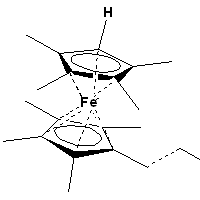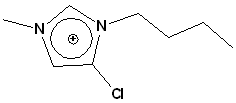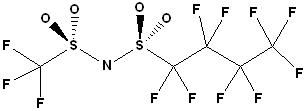Below, you will find force-field (FF) files for various molecules and ions, which can be easily used with DLPGEN to generate input files for simulations using DL_POLY, LAMMPS, GROMACS, or CHARMM. This list will be continuously updated over time, so please check back regularly if you need files for a new system. Each molecule's file can be downloaded individually. To run the program, you will also need to download the CL&P [1] force field file. Note that this FF is based on OPLS-AA parameterization [2], allowing for the extension of the data in the library file using information from the literature if needed. The nomenclature used is consistent with that in the CL&P papers, and each GEN file includes a schematic view with labeled atoms of the molecules. Additional information about the force field origin of each molecule is also included in each file. The DLPGEN program manual can also be downloaded from this page (a copy is also included with the program package).
If you require any other molecule, please contact me. Always check the content of the files generated by DLPGEN. While the documents available for download are generally correct, errors can occur during the preparation of the input files for this webpage. Therefore, I am not liable for any issues arising from the use of the information contained on this website.
Please keep your force field file (cl_p.lib) updated when downloading new GEN files, as they may require parametrization not included in old versions.
(Last update 28-05-2024)
Name |
Structure |
File |
1-methyl-n-alkylimidazolium (n= 2-10, 18) |
 |
|---|---|---|
1-alkyl-2,3,4,5,6,7,8,9-octamethylferrocenium (n=3-8 and 10)] |

|
|
2-hydroxy-N,N,N-trimethylpropylaminium |
 |
|
3-hydroxy-N,N,N-dimethylethylaminium |
 |
|
propyl-N,N,N-tetrabutylammonium |
 |
|
N-ethyl-N,N-dimethylbutan-1-aminium |
 |
|
ammonium |
 |
|
tetraethylammonium |
 |
|
N-ethyl-2-methoxy-N,N-dimethylethanaminium |
 |
|
1,1-dimethylpyrrolidinium |
 |
|
1,2,3,4,5-pentamethylimidazolium |
 |
|
2-Ethyl-1,3-diisopropyl-4,5-dimethylimidazol-3-ium |
 |
|
1-Isopropyl-3-methyl-1H-imidazolium |
 |
C1_H_iC3_H_H_im |
1-Allyl-3-methylimidazolium |
 |
|
4,5-diiodo-1-ethyl-3-methylimidazolium |
 |
|
2-Chloro-2,3-dihydro-1,3-diisopropyl-4,5-dimethylimidazol-2-ium |
 |
|
2-Bromo-2,3-dihydro-1,3-diisopropyl-4,5-dimethylimidazol-2-ium |
 |
|
2-Iodo-2,3-dihydro-1,3-diisopropyl-4,5-dimethylimidazol-2-ium |
 |
|
1-Allyl-2,4,5-tribromo-3-methyl-1H-imidazol-3-ium |
 |
|
1-Allyl-2,4,5-tribromo-3-ethyl-1H-imidazol-3-ium |
 |
|
1,3-Diethyl-2-iodo-4,5-dimethylimidazolium |
 |
|
4,5-Dichloro-1,3-dimethylimidazolium |
 |
|
4,5-Dichloro-1-methyl-2-ethyl-imidazolium |
 |
|
4,5-dichloro-1-n-butyl-3-methyl-1H-imidazol-3-ium |
 |
|
4-chloro-1-n-butyl-3-methyl-1H-imidazol-3-ium |
 |
|
5-chloro-1-n-butyl-3-methyl-1H-imidazol-3-ium |
 |
|
4,5-Di-iodo-3-methyl-1-propyl-1H-imidazol-3-ium |
 |
|
4,5-Di-iodo-3-methyl-1-butyl-1H-imidazol-3-ium |
 |
|
4,5-Dibromo-1-n-butyl-3-methyl-1H-imidazol-3-ium |
 |
|
4,5-Dibromo-3-methyl-1-propyl-1H-imidazol-3-ium |
 |
|
4,5-dibromo-1-ethyl-3-methylimidazolium |
 |
|
1-butyl-1-methylmorpholinium |
 |
|
Benzyltriethylammonium |
 |
|
Name |
Structure |
File |
|---|---|---|
Poly-1-vinyl-3-ethylimidazolium |
 |
pvemim n=101 |
Poly(p-vinylbenzyltriethylammonium) |
 |
Name |
Structure |
File |
|---|---|---|
acetate |
 |
|
trifluoroacetate |
 |
|
alkylsulnate (n = 2, 4, 6 and 8) |
 |
|
ethylsulfate |
 |
|
chloride |
Cl- | |
bromide |
Br- | |
Iodide |
I- | |
nitrate |
 |
|
thiocyanate |
||
triflate |
 |
|
bistriflimide |
 |
|
bis(fluorosulfonyl)amide |
 |
|
((perfluorobutyl)sulfonyl) ((trifluoromethyl)sulfonyl) amide |
 |
fc4c1si_old |
bis[(pentafluoroethyl)sulfonyl]imide |
 |
|
2,2,2-trifluoro-N-(trifluoromethylsulfonyl) acetamide |
 |
|
2,2,2-(trifluoromethyl) sulfonyl-N-cyanoamide |
 |
|
nonafluorobutanesulfonate |
 |
|
hexafluorophosphate |
 |
|
tetrafluoroborate |
BF4- | |
tris(pentafluoroethyl) trifluorophosphate |
 |
|
dicyanamide |
 |
|
Bicarbonate |
 |
|
2-chloro-1-phenylethanolate |
 |
|
Name |
Structure |
File |
|---|---|---|
Water |
||
1,2-ethanodiol |
||
ethanol |
||
1,2-butanodiol |
 |
|
1,2-pentanodiol |
 |
|
ethoxythanol |
 |
|
1,2-heaxanodiol |
 |
|
1,3-propanodiol |
||
1,5-pentanodiol |
||
2,3-butanodiol |
 |
|
1-alkyl-alcohol (n=4, 5, 6, 8) |
||
heptane |
||
urea |
 |
|
dimethylsulfoxide |
 |
|
ketone |
 |
|
tetrahydrofuran |
 |
|
Carbon dioxide |
 |
|
Styrene oxide |
 |
|
[1] J.N. Canongia Lopes, A.A.H. Pádua; Theor. Chem. Acc. 2012, 131, 1129.
[2] W.L. Jorgensen, D.S. Maxwell, J. Tirado-Rives; J. Am. Chem. Soc. 1996, 118, 11225–11236.
